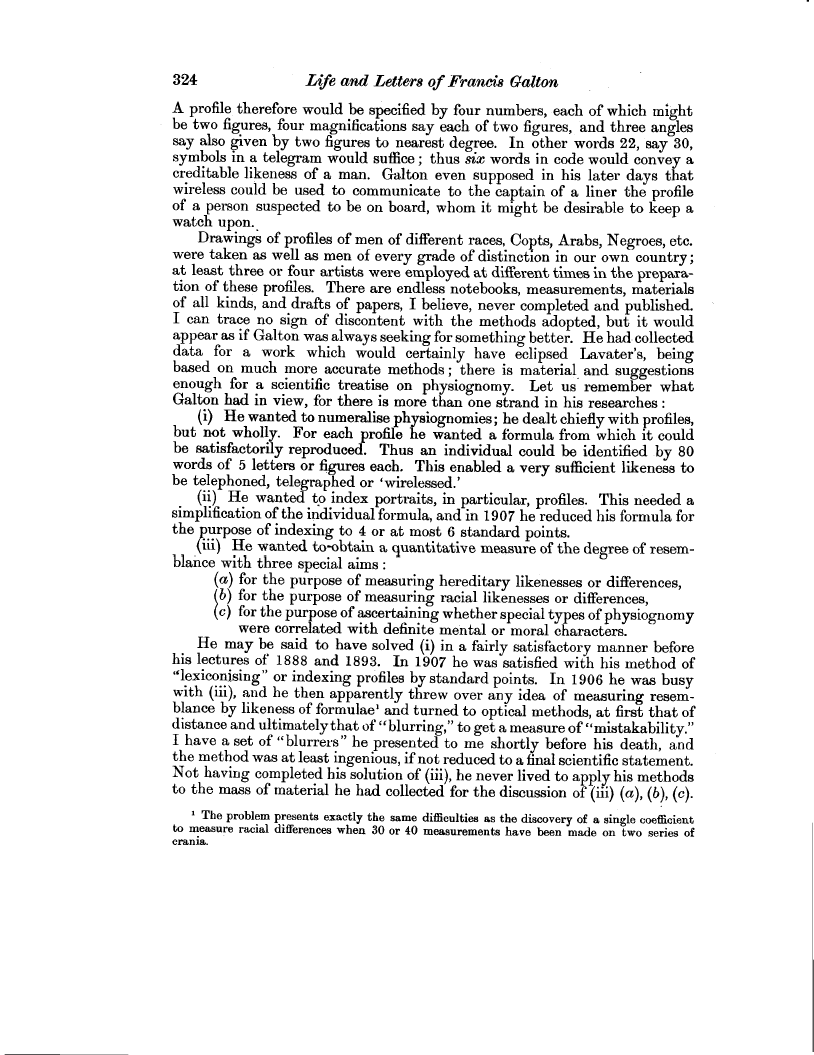324 Life and Letters of Francis Galton
A profile therefore would be specified by four numbers, each of which might be two figures, four magnifications say each of two figures, and three angles say also given by two figures to nearest degree. In other words 22, say 30, symbols in a telegram would suffice ; thus six words in code would convey a creditable likeness of a man. Galton even supposed in his later days that wireless could be used to communicate to the captain of a liner the profile of a person suspected to be on board, whom it might be desirable to keep a watch upon.
Drawings of profiles of men of different races, Copts, Arabs, Negroes, etc. were taken as well as men of every grade of distinction in our own country; at least three or four artists were employed at different times in the preparation of these profiles. There are endless notebooks, measurements, materials of all kinds, and drafts of papers, I believe, never completed and published. I can trace no sign of discontent with the methods adopted, but it would appear as if Galton was always seeking for something better. He had collected data for a work which would certainly have eclipsed Lavater's, being based on much more accurate methods ; there is material_ and suggestions enough for a scientific treatise on physiognomy. Let us remember what Galton had in view, for there is more than one strand in his researches
(i) He wanted to numeralise physiognomies; he dealt chiefly with profiles, but not wholly. For each profile he wanted a formula from which it could be satisfactorily reproduced. Thus an individual could be identified by 80 words of 5 letters or figures each. This enabled a very sufficient likeness to be telephoned, telegraphed or 'wirelessed.'
(ii) He wanted to index portraits, in particular, profiles. This needed a simplification of the individual formula, and in 1907 he reduced his formula for the purpose of indexing to 4 or at most 6 standard points.
(iii) He wanted to-obtain a quantitative measure of the degree of resemblance with three special aims
(a) for the purpose of measuring hereditary likenesses or differences,
(b) for the purpose of measuring racial likenesses or differences,
(c) for the purpose of ascertaining whether special types of physiognomy
were correlated with definite mental or moral characters.
He may be said to have solved (i) in a fairly satisfactory manner before his lectures of 1888 and 1893. In 1907 he was satisfied with his method of "lexiconising" or indexing profiles by standard points. In 1906 he was busy with (iii), and he then apparently threw over any idea of measuring resemblance by likeness of formulae' and turned to optical methods, at first that of distance and ultimately that of "blurring," to get a measure of "mistakability." I have a set of "blurrers" he presented to me shortly before his death, and the method was at least ingenious, if not reduced to a final scientific statement. Not having completed his solution of (iii), he never lived to apply his methods to the mass of material he had collected for the discussion of (iii) (a), (b), (c).
' The problem presents exactly the same difficulties as the discovery of a single coefficient to measure racial differences when 30 or 40 measurements have been made on two series of crania.

